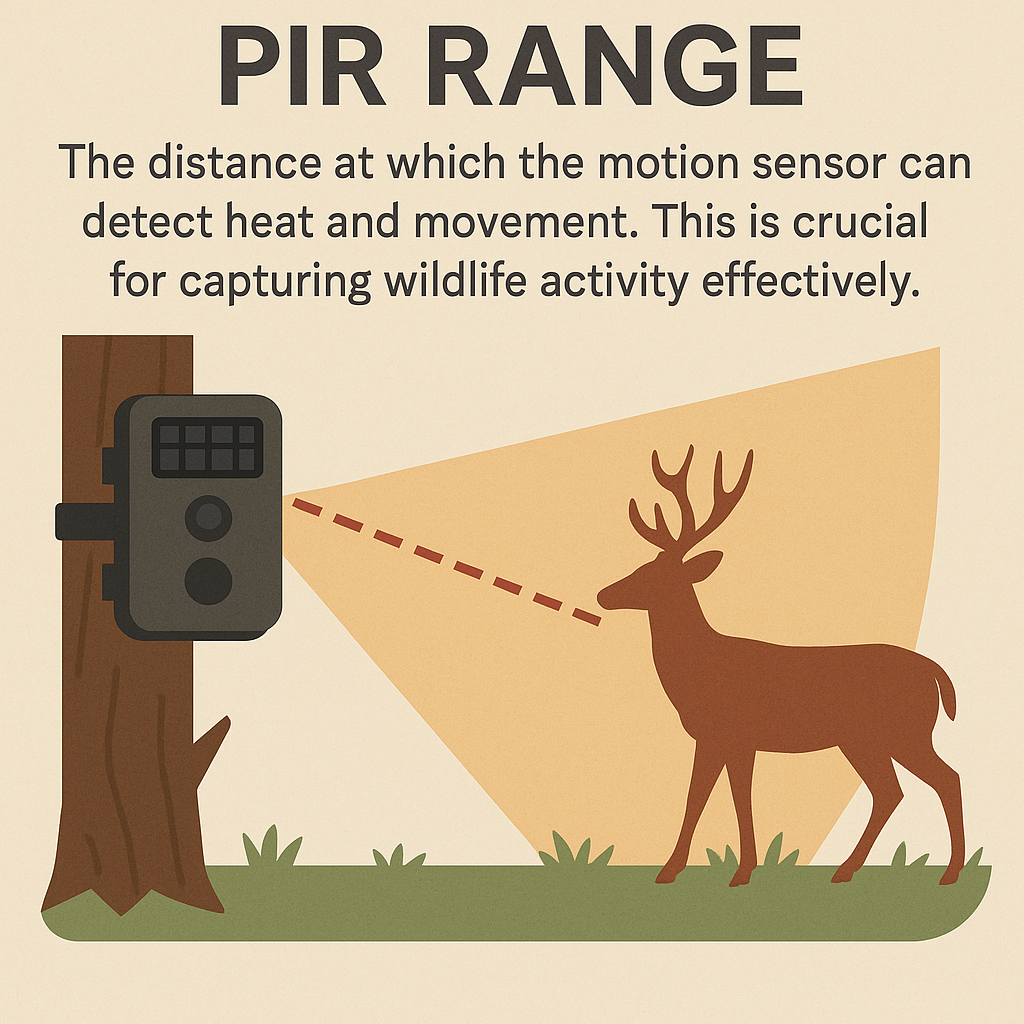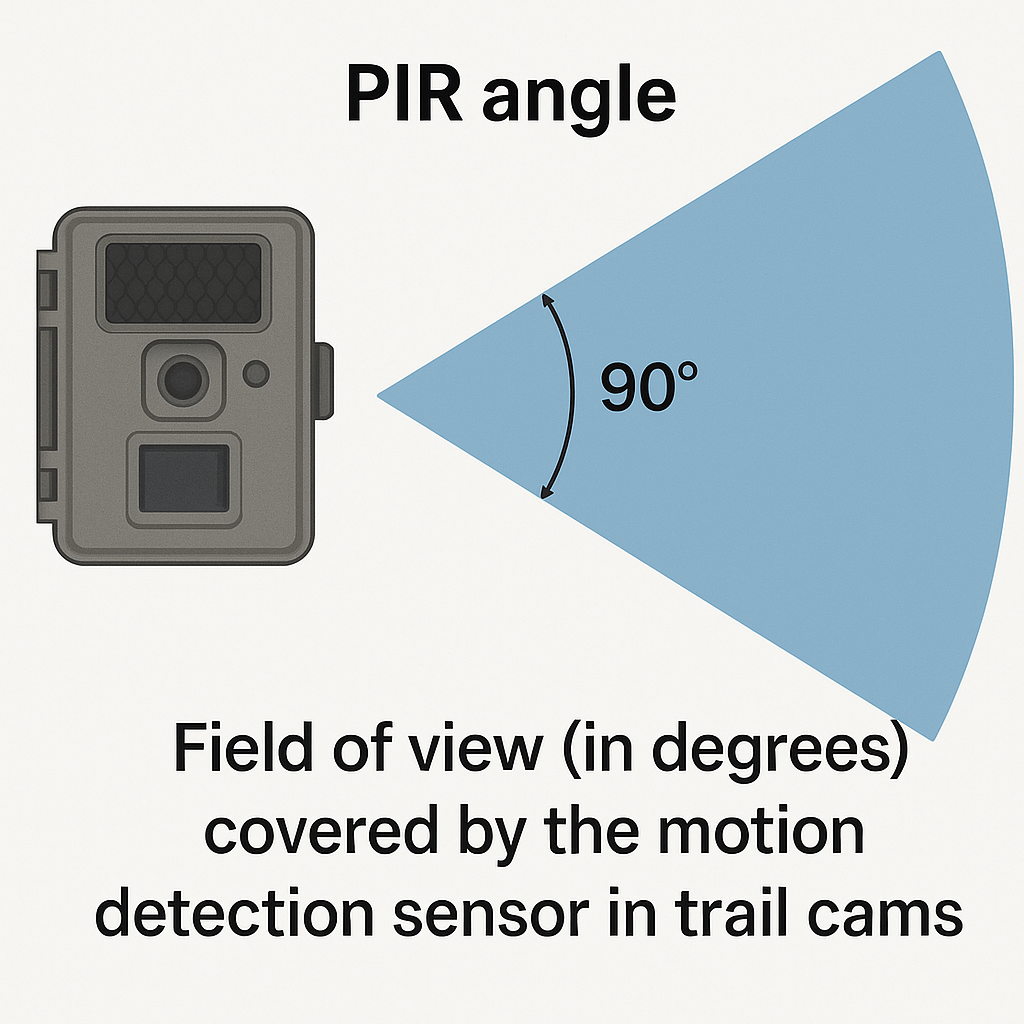Passive Infrared Sensor (PIR) in Trail Cameras
Discover how Passive Infrared Sensors (PIR) enhance trail cameras, enabling motion detection through heat changes and ensuring energy efficiency.
The distance at which the motion sensor can detect heat and movement. This is crucial for capturing wildlife activity effectively.

| Common Values | Description |
|---|---|
| Short Range | Short range (10-15 meters) is suitable for close-up monitoring in dense woods or baited areas. It minimizes false triggers from distant movement. |
| Moderate Range | Moderate range (15-25 meters) is ideal for mixed environments, balancing detection distance and minimizing false triggers. It works well in various settings. |
| Long Range | Long range (25+ meters) is best for open fields or large properties. It allows early detection of movement, making it suitable for boundary monitoring and wildlife research. |
| Extended Range | Extended range (30+ meters) is designed for expansive areas, providing maximum detection distance. It is ideal for large properties or wildlife research in open environments. |
| Adjustable Range | Adjustable range allows users to customize the detection distance based on their specific needs. This feature is useful for adapting to different environments and minimizing false triggers. |
Trail cameras use a PIR (Passive Infrared) sensor to spot movement. This sensor picks up changes in heat, usually from people or animals, compared to the background. When something warmer or colder than its surroundings passes by, the camera’s sensor notices this change and triggers a photo or video. The PIR range is the farthest distance from the camera where it can still pick up this heat-based movement. This distance is usually listed in meters or feet. It’s important to remember that PIR range is about how far away the sensor can detect movement, not how far the camera can take a clear picture at night or with its flash.
PIR range affects how well a trail camera does its job. If the sensor’s range is too short, you might miss animals or people passing through the area, and you won’t get the footage you want. If the range is right for your setup, your camera will catch movement as soon as it happens, so you don’t miss anything important. A good PIR range also helps cut down on empty photos and videos triggered by things like wind-blown leaves or animals far in the background. Picking a camera with a PIR range that matches your needs will help you cover a bigger area more easily and get more useful results.
A longer PIR range, usually around 25 meters (about 80 feet) or more, is helpful in open spaces. If you set up your camera along game trails that cross open fields, or if you’re watching a large property boundary, you’ll want to spot movement as early as possible. This longer range gives you a better chance of catching animals or people before they move out of view. For landowners and property managers, a longer PIR range means you get more time to see and react to movement along a fence line or boundary. Wildlife researchers also benefit from cameras with a longer PIR range, since they can monitor bigger areas without needing as many cameras or as much time spent checking them.
In thick woods, brushy spots, or places with bait, a moderate PIR range—about 10 to 20 meters (33 to 66 feet)—usually works better. In these spots, animals are likely to come close to the camera, so you don’t need a long range. In fact, a long range can cause more false triggers from things like waving branches, small animals, or distant movement. If you’re using a trail camera in a backyard, neighborhood, or near a house, a moderate range also helps avoid picking up cars, pets, or people far from the camera. Limiting the range can also help you get sharper, better-framed shots of animals up close.
Most trail cameras have a PIR range of 10 to 30 meters (33 to 100 feet). Some basic models give you about 10–15 meters, which is enough for small clearings or spots where you expect animals to come close. Higher-end models, like the Spartan Eclipse, can reach up to 30 meters (100 feet), great for bigger or more open areas. Some top models, such as the Stealth Cam Deceptor, go up to 36 meters (120 feet). Keep in mind, though, that a longer range might mean more false triggers if you use the camera in a place with lots of background movement. It’s important to match the PIR range to your environment so you get the best results.
PIR range isn’t the only thing that matters for motion detection. The width of the sensor’s detection area, called the PIR angle, shows how much space the camera can watch side-to-side. A wider angle means you’ll cover more ground, but you might also get more false alarms if there’s a lot going on in the background. Trigger speed—the time it takes for the camera to snap a picture after sensing movement—makes sure you don’t miss fast-moving animals. Recovery time is how soon the camera is ready to take another photo or video after the first one. All of these features work together. For example, in thick woods, a camera with a moderate range, wide angle, and quick trigger speed is a good fit. In big open areas, a long-range, narrower-angle camera might be better.
Most trail cameras let you adjust sensitivity to help fine-tune how far away the camera detects movement. Before buying, check the manufacturer’s details and read reviews to see if the PIR range works well in real-world situations like yours.
PIR range is one of the main things that decides how well your trail camera will catch the action you want. Pick a range that fits where you’ll use the camera—wide open field, thick forest, or backyard—and think about the type of animals or people you’re trying to spot. When choosing a camera, look at the range, the width of the detection area, the trigger speed, and how quickly it can get ready for the next shot. Getting these details right means you’ll get more useful photos and videos, and you won’t waste time sorting through empty or unwanted shots. Taking the time to match the PIR range to your needs will help you get the best results from your trail camera.
Knowing how PIR range works, and what it means for your setup, helps you pick the right trail camera for your situation. Whether you’re hunting, watching your property, or studying wildlife, choosing the best PIR range will help you get the information and images you’re after.
Discover how Passive Infrared Sensors (PIR) enhance trail cameras, enabling motion detection through heat changes and ensuring energy efficiency.

Learn about PIR triggers in trail cameras, their functionality, benefits, and applications in wildlife monitoring and security.